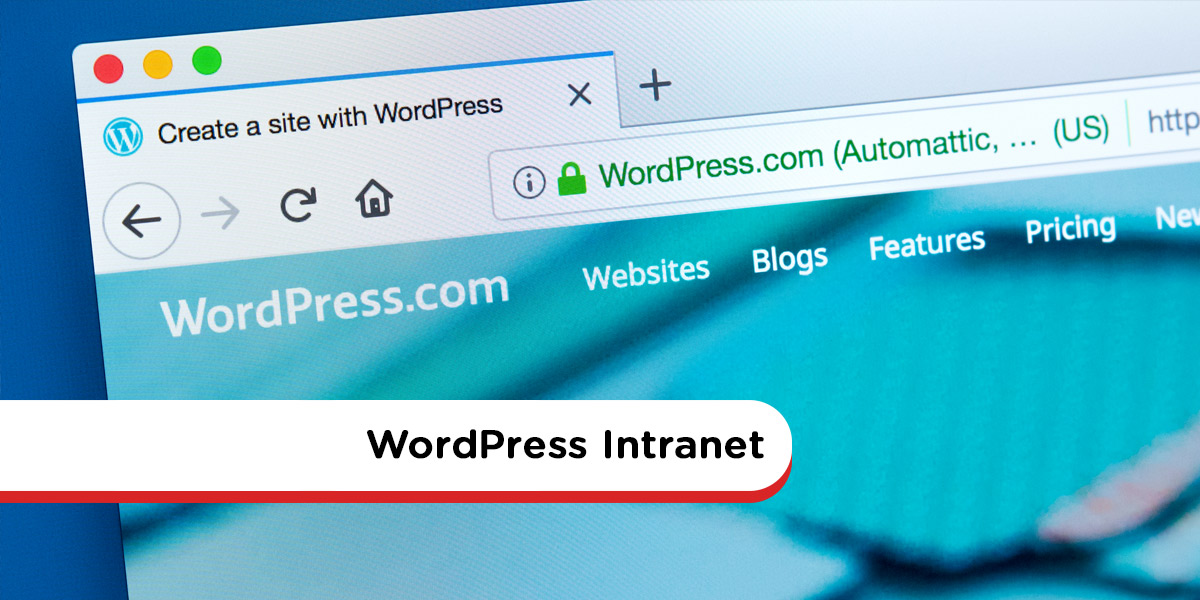A WordPress intranet can be an appealing option for organizations looking to create an intranet site, especially if WordPress already powers your public website. As a free and open-source content management system (CMS), WordPress is the most widely used website platform in the world. In fact, recent research shows that 43 percent of all websites globally use WordPress. When narrowed to CMS usage, WordPress dominates with an impressive 64 percent market share.
There’s no doubt that for public-facing sites and blogs, WordPress is a powerful platform. It’s free to use, highly customizable, and supported by a massive library of plugins and themes. Naturally, it may seem like the logical choice for building your intranet. But how well does WordPress perform as an intranet platform for internal business use?
In this guide, we dive into what it takes to set up a WordPress intranet site and evaluate some of the biggest challenges, so you can make a more informed decision.
Can You Use WordPress As An Intranet?
Yes, you can use WordPress to build an intranet. The first step is to install WordPress on a public web server and choose a suitable theme. While any theme can work, options like the intranet-specific “Woffice” theme are good starting points.
To keep your intranet secure and internal-facing, install the all-in-one intranet plugin to restrict access. This plugin ensures that only authorized users within your organization can view the site.
There are two main ways to configure a WordPress intranet:
- Locally Hosted Intranet: Using tools like XAMPP or WAMP, your intranet will only be accessible within your office’s local network.
- Hosted WordPress Site With Plugins: Allows employees to securely access the intranet from any location with an internet connection.
Essential Plugins And Themes For A WordPress Intranet
Once your site is live, it’s time to decide which WordPress intranet plugins best meet your needs. With thousands of options available, choosing the right ones depends on your intranet’s intended features. Below are popular tools to consider:
- BuddyPress: This plugin transforms your site into a private social network. It enables internal communication through private messaging, user groups, and team discussions.
- Heroic Knowledge Base: Create a searchable internal knowledge base for employees, complete with FAQs, how-to guides, and embedded documents.
- WP Project Manager: Streamline team collaboration with built-in project tracking, task assignments, and milestone monitoring.
- Google Drive Embedder: Allow users to access and share files from Google Drive directly within WordPress pages, ideal for teams already using Google Workspace.
- Private Direct Access: Enhance document security by restricting unauthorized users and bots from accessing uploaded media and sensitive files.
- Gravity Forms: Build and manage customizable forms and employee surveys. It’s ideal for collecting internal feedback and running HR polls or workflows.
WordPress Intranet – 7 Key Challenges
Watch our video overview of WordPress intranet pitfalls
While a WordPress intranet site can be a flexible solution, it’s not without challenges. From technical complexity to long-term scalability, you’ll need to approach implementation with eyes wide open. Below are common issues to consider before you get started.
1. WordPress Intranet – Build Or Buy?
Should you build your own WordPress intranet or purchase a purpose-built solution? A custom setup hosted on a local server may seem like an attractive option for organizations with dedicated IT resources. It promises full control and customization tailored to your needs.
However, there are downsides:
- Building from scratch can be time-consuming and resource-intensive.
- You’ll need physical infrastructure (like a local server) unless you host externally with added security layers.
- Maintenance, updates, and data security fall entirely on your internal team.
At first glance, WordPress appears cost-effective and simple to manage. But in reality, you’re taking on a complex system that wasn’t designed for intranet use. Add to that the need for hosting, limited plugin flexibility, and possible long-term scalability issues, and you might be better off exploring specialized intranet software solutions.
2. Is WordPress Easy To Use For Intranets?
For most businesses, especially SMBs without IT departments, ease of use is a top priority. While WordPress is beginner-friendly for websites and blogs, it gets far more complicated when used to build an intranet.
At MyHub, we’ve heard from many users who began their intranet journey on WordPress. They quickly realized that while the five-minute install is simple, expanding functionality through plugins, managing permissions, and customizing workflows becomes overwhelming.
WordPress was never built as intranet software. To fill the gaps, you’ll rely on third-party plugins, some of which are outdated, unsupported, or not secure. Many essential features (like user access control or document management) require advanced knowledge of CSS, PHP, and server administration.
Furthermore, your costs may creep up quickly. While some plugins are free, others require licenses or subscriptions. And unless you have in-house developers, you’ll need to hire external support to customize or troubleshoot your site, adding further to your budget.
Bottom line: A WordPress intranet might work for tech-savvy teams, but for most organizations, it lacks the out-of-the-box simplicity, support, and scalability that modern intranet solutions provide.
3. WordPress Intranet Themes & Plugins
We’ve already touched on the importance of WordPress intranet plugins and themes, but this area is critical enough to deserve a deeper dive.
At first glance, WordPress seems like a highly flexible platform. With over 60,000 plugins and thousands of themes available, it promises virtually endless customization for your intranet. However, the reality is more complex than it first appears.
Say your intranet needs two core features: an employee directory and a shared company calendar. You’ll likely install plugins such as BuddyPress for staff profiles and Sugar Calendar for scheduling. But each function requires a separate plugin, and each may be developed by a different supplier, ranging from individual developers to larger companies.
Managing these multiple vendors can quickly become a headache. They’ll have different support standards, update cycles, and compatibility issues with your chosen theme or other plugins. This disjointed development often leads to inconsistent user interfaces and a fragmented user experience.
Moreover, while many plugins are labeled as “free,” they often act as gateways to premium, paid versions. And sometimes, the free version doesn’t come close to meeting your actual needs.
Using various plugins from different developers makes it impossible to guarantee that all components will work together seamlessly with your theme. In most cases, you’ll need to get hands-on with custom CSS to fix layout issues or conflicts between stylesheets.
Notably, if you search the WordPress theme library for the term “intranet,” you’ll receive a “no themes found” result. This underlines the reality that WordPress is not inherently built for intranet design, and often falls short of delivering a consistent, user-friendly intranet experience.
4. WordPress Intranet Site Performance
Page load speed is a critical performance metric, especially for front-line employees or those accessing your intranet from mobile devices while traveling or working remotely.
Your intranet must be fast, responsive, and optimized for real-time access. No matter how attractive or content-rich your intranet is, it will fail if pages load slowly. Staff will revert to email chains or outdated paper systems, reducing overall efficiency and undermining your digital investment.
Unfortunately, WordPress intranet performance is often hampered by the very plugins meant to enhance it. The more plugins you install, the greater the risk of slower load times. Caching, minifying scripts, and optimizing your database are technical tasks that require deep knowledge of web performance optimization, and few SMEs have these resources in-house.
5. WordPress Intranet Security
WordPress security has long been a hot topic. Its immense popularity has made it a prime target for hackers, botnets, and SQL injection attacks. Although recent updates have strengthened the core system, the security of your WordPress intranet largely depends on the third-party plugins you use.
Each new plugin introduces a potential vulnerability. Many are not regularly updated or audited, especially if developed by individual contributors. Maintaining security patches and plugin updates is your full responsibility, and failing to do so can expose your intranet to data breaches.
Want to implement features like SSL encryption or move your site to HTTPS? That too falls entirely on you. In contrast, professionally hosted intranet platforms often handle these critical updates and security measures automatically.
6. WordPress Intranet Costs
Cost is a major consideration for any organization looking to implement an intranet solution. While WordPress is free as an open-source CMS, the hidden costs of creating a secure, fully functional WordPress intranet can quickly add up.
If you don’t already have on-premises infrastructure, you’ll need to pay for WordPress hosting. More importantly, many of the critical features your intranet needs, like secure document management, employee surveys, or access control, will require premium plugins and themes.
And as your intranet grows in complexity, you’ll likely need to hire an experienced WordPress developer or consultant to manage the build, ensure security, and maintain ongoing compatibility. These services come at a premium, and few SMEs have this talent in-house.
So while WordPress seems cost-effective on the surface, a full-featured WordPress intranet often incurs significant hidden expenses. When compared to a purpose-built intranet platform that includes everything in one predictable subscription, the long-term costs can be surprisingly high.
7. WordPress Intranet Support
One important factor when considering a WordPress intranet is the level of ongoing support. What happens when you encounter a technical issue? Who do you contact for help with plugin conflicts or site performance?
A major advantage of WordPress is its massive global user base. With one of the largest online developer communities, WordPress offers a variety of support options including official forums, developer handbooks, and thousands of blog tutorials. You can also use these resources to build an internal knowledge base for staff support.
However, it’s worth noting that WordPress support is mostly self-service. If you’re looking for dedicated, hands-on technical assistance, your options are limited unless you hire a developer. For many businesses, especially SMEs without internal IT teams, this lack of real-time help can be frustrating and inefficient.
Final Thoughts On How To Create A WordPress Intranet
There’s no denying that WordPress is a powerful tool for website development and blogging, this very blog is built on WordPress. But when it comes to building a secure, scalable, and user-friendly intranet, the platform has significant limitations.
For small organizations with tight budgets and limited needs, a WordPress intranet might seem sufficient. If you’re only looking to implement basic functionality, such as static pages or a simple file repository, WordPress can do the job. However, many businesses soon discover that they’ve outgrown WordPress’s core capabilities and end up bogged down in a confusing mix of plugins, themes, and workarounds.
Fortunately, there is a better option. If you’re searching for a solution designed specifically for internal communication and collaboration, it’s time to consider a cloud-based intranet.
WordPress Intranet Alternative – Cloud Intranets
Cloud intranets offer several significant advantages over a DIY WordPress solution. These purpose-built platforms are designed to meet the modern workplace’s intranet needs, right out of the box. Key benefits include:
- Customizable intranet templates with built-in features like instant messaging, staff directories, and discussion boards
- No technical expertise required to set up or manage
- Fast deployment using pre-configured components
- Easy content and user management from an intuitive dashboard
- Externally hosted with robust online security, including SSL encryption and regular backups
- Mobile-friendly with dedicated intranet apps for remote access
- Reliable uptime and performance, typically 99.99%
- Updates, backups, and security are handled by the provider
- All-in-one functionality, no third-party plugins or add-ons required
- Fixed monthly pricing for predictable budgeting
- Unlimited file and data storage included
- Personalized support from a dedicated team of intranet experts
Get Started On Your Cloud Intranet Today!
If you want to launch a feature-rich intranet with zero technical hassle, a cloud-based intranet solution is the best choice. Unlike WordPress, cloud intranets are specifically engineered to streamline internal communication, document sharing, and employee engagement, all in one platform.
Reach out to the team at MyHub to learn more. As a trusted intranet provider, we’ve helped hundreds of businesses across industries. Get started with a free demo or 14-day trial and see how easy it is to transform your internal communications.
FAQ Section
Can WordPress really function as a secure intranet?
Yes—with proper access-restriction plugins and secure hosting, WordPress can serve as an intranet, though it requires thoughtful configuration.
What’s the difference between building with WordPress vs. using dedicated intranet software?
WordPress allows customization with plugins but demands more technical effort and maintenance, whereas dedicated intranet platforms offer built-in features, support, and scalability.
Do I need IT expertise to run a WordPress intranet?
Moderate technical skills are essential for setup, plugin management, security, server upkeep, and troubleshooting—otherwise, you may need external help or consider a managed intranet solution.



